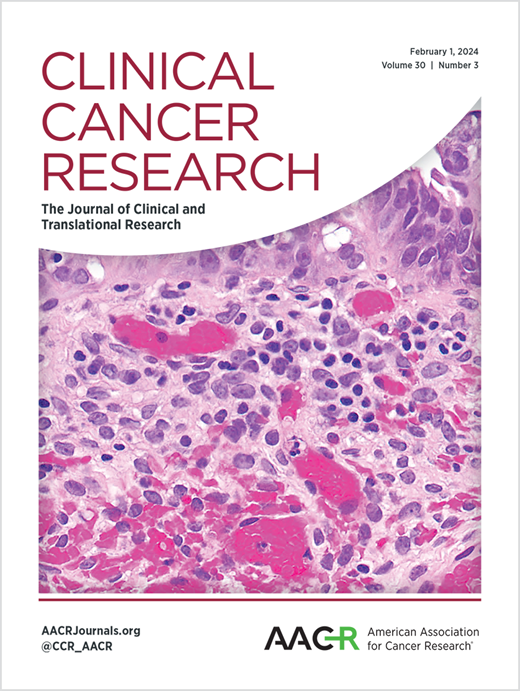Cadonilimab (a PD-1/CTLA-4 bispecific antibody) Plus Neoadjuvant Chemotherapy in Locally Advanced Head and Neck Squamous Cell Carcinoma: A Phase Ⅱ Clinical Trial.
IF 10.2
1区 医学
Q1 ONCOLOGY
引用次数: 0
Abstract
PURPOSE Preclinical and clinical findings suggest that programmed cell death protein 1 (PD-1) /cytotoxic T-lymphocyte-associated protein 4 (CTLA-4) bispecific antibodies may offer synergistic anti-tumor activity. This study aimed to explore the efficacy and safety of cadonilimab combined with neoadjuvant chemotherapy in locally advanced, resectable head and neck squamous cell carcinoma (HNSCC). PATIENTS AND METHODS Eligible patients were consecutively enrolled and received cadonilimab (10 mg/kg) and chemotherapy (docetaxel, 75 mg/m2 plus cisplatin, 60 mg/m2) every 3 weeks for three cycles. The primary endpoint was objective response rate (ORR). Secondary endpoints included disease control rate (DCR), pathological complete response (PCR), major pathological response (MPR), safety, progression-free survival (PFS), and overall survival (OS). Analyses of biomarkers and tumor-infiltrating immune cell subsets were conducted. This study is registered with ClinicalTrials.gov (NCT06023875). RESULTS Thirty patients were included from July 2023 to December 2023. The median age was 55 years (range: 26-69) and 27 patients (90.0%) were male. The ORR was 83.3%, DCR was 100.0%, MPR rate was 76.7% and PCR rate was 50.0%. All patients experienced treatment-related adverse events (TRAEs). Grade 3 TRAEs were reported in 7 (23.3%) patients. PFS and OS data were not yet mature as of the cutoff date (February 1,2025). Subgroup analysis revealed no significant differences in biomarker expression. A higher baseline infiltration of M1-like macrophage in the tumor stroma was associated with better treatment efficacy. CONCLUSIONS Cadonilimab plus neoadjuvant chemotherapy demonstrated favorable ORR and MPR with manageable toxicities in patients with HNSCC.卡多尼利单抗(PD-1/CTLA-4双特异性抗体)加新辅助化疗治疗局部晚期头颈部鳞状细胞癌:Ⅱ期临床试验
目的临床前和临床研究结果表明,程序性细胞死亡蛋白1 (PD-1) /细胞毒性t淋巴细胞相关蛋白4 (CTLA-4)双特异性抗体可能具有协同抗肿瘤活性。本研究旨在探讨卡多尼单抗联合新辅助化疗治疗局部晚期可切除的头颈部鳞状细胞癌(HNSCC)的疗效和安全性。患者与方法符合条件的患者连续入组,每3周接受卡多尼利单抗(10mg /kg)和化疗(多西他赛75mg /m2 +顺铂60mg /m2),共3个周期。主要终点为客观缓解率(ORR)。次要终点包括疾病控制率(DCR)、病理完全缓解(PCR)、主要病理缓解(MPR)、安全性、无进展生存期(PFS)和总生存期(OS)。对生物标志物和肿瘤浸润免疫细胞亚群进行分析。该研究已在ClinicalTrials.gov注册(NCT06023875)。结果入选患者30例,时间为2023年7月至2023年12月。中位年龄为55岁(范围:26-69岁),27例(90.0%)为男性。ORR为83.3%,DCR为100.0%,MPR为76.7%,PCR为50.0%。所有患者均出现治疗相关不良事件(TRAEs)。7例(23.3%)患者出现3级trae。截止日期(2025年2月1日),PFS和OS数据尚未成熟。亚组分析显示生物标志物表达无显著差异。肿瘤基质中m1样巨噬细胞基线浸润越高,治疗效果越好。结论scadonilumab联合新辅助化疗对HNSCC患者具有良好的ORR和MPR,且毒性可控。
本文章由计算机程序翻译,如有差异,请以英文原文为准。
求助全文
约1分钟内获得全文
求助全文
来源期刊

Clinical Cancer Research
医学-肿瘤学
CiteScore
20.10
自引率
1.70%
发文量
1207
审稿时长
2.1 months
期刊介绍:
Clinical Cancer Research is a journal focusing on groundbreaking research in cancer, specifically in the areas where the laboratory and the clinic intersect. Our primary interest lies in clinical trials that investigate novel treatments, accompanied by research on pharmacology, molecular alterations, and biomarkers that can predict response or resistance to these treatments. Furthermore, we prioritize laboratory and animal studies that explore new drugs and targeted agents with the potential to advance to clinical trials. We also encourage research on targetable mechanisms of cancer development, progression, and metastasis.
 求助内容:
求助内容: 应助结果提醒方式:
应助结果提醒方式:


